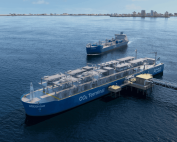In a forward-thinking collaboration, DNV and Vaisala released extensive guidelines for using scanning lidars in a dual system configuration (DSL) for offshore Wind Resource Assessment (WRA).
Dual scanning lidar is increasingly replacing meteorological masts for offshore wind park developments near the shore (up to 15 km), enabling offshore wind project developers to reduce extrapolation uncertainties and gain an even more comprehensive picture of the wind resource at the planning areas. A major advantage is that DSL can measure the wind speed and direction at multiple offshore locations remotely from the shore.
Jointly drafted by experts from DNV and Vaisala, the global leader in measurement instruments and intelligence for climate action, the release of the new guidelines helps improving dual scanning lidar bankability and contributes to creating the International Energy Agency (IEA) Task 52 – recommended practice on using scanning lidar measurements offshore.
Sharing practical insights and best practices, the robust documentation details a typical campaign workflow and the individual steps to maximize reliability and minimize uncertainties before a campaign begins, facilitating decision-making and making DSL technology more accessible to stakeholders across the wind energy sector.
The Dual Scanning Lidar Principle section explains the math for reconstructing horizontal wind speed and direction from two line-of-sight wind speed measurements, discussing factors influencing uncertainty like beam geometry, mode of operation, scan parameters, and environmental conditions. The document also emphasizes proper setup, alignment checks, performance monitoring, data collection, and maintenance procedures and provides proprietary methods to calculate uncertainties of intermediate and final reconstructed values.
Guideline details
The collaborative document outlines the different phases of a typical DSL campaign for wind resource assessment:
• Campaign planning.
• Lidar pre-campaign verification.
• Installation and commissioning.
• Operation and monitoring of the specific measurement campaign.
• Data processing.
• Uncertainty evaluation.
• Decommissioning and post-campaign verification.
“The maturity of DSL systems now allows us to confidently utilize them for bankable wind resource assessments. By releasing this guideline, we aim to accelerate the adoption of DSL technology, empowering industry professionals to harness its full potential in driving sustainable energy solutions.” says Robert Menke, Senior Engineer at DNV.
“With the global urgency to transition to more renewable energy sources growing every moment, equipping industry professionals with the tools and knowledge needed to expedite this process is imperative”, adds Dominic Champnays, Research and Application Engineer at Vaisala. “Working with DNV to provide wind industry professionals with comprehensive guidelines for DSL-driven wind resource assessments helps our customers overcome critical challenges and harness the full potential of the wind — on and offshore.”
Source: DNV














